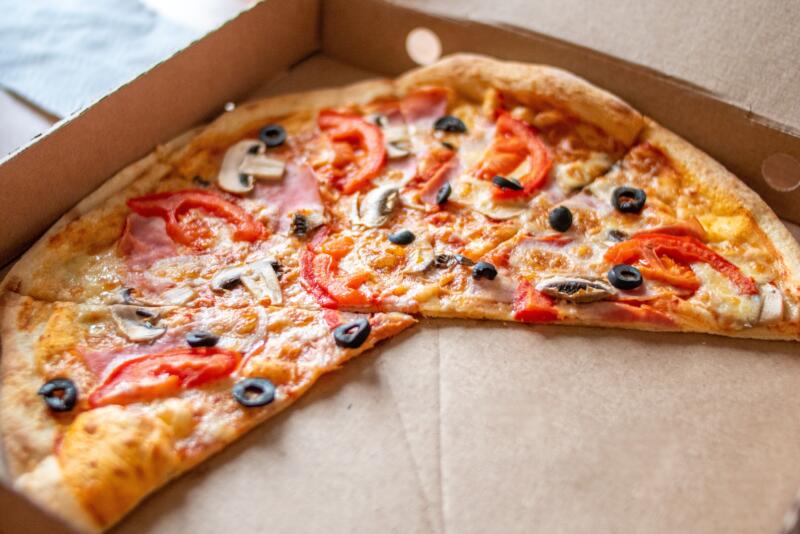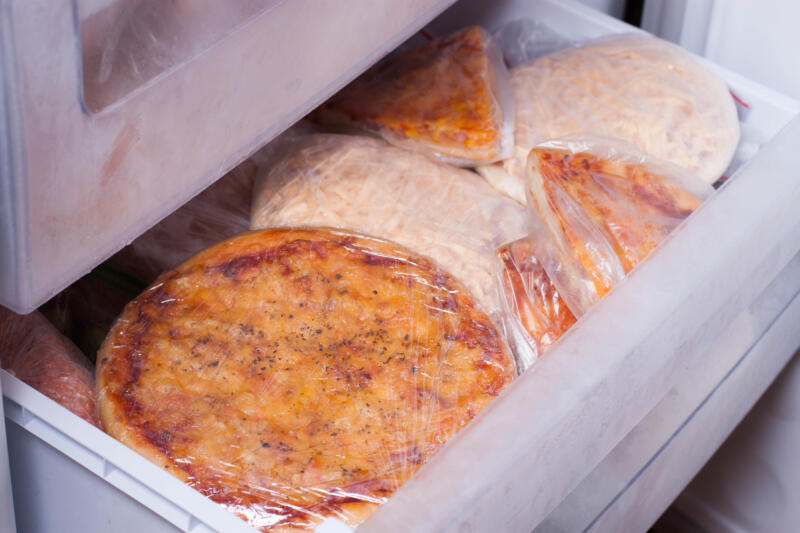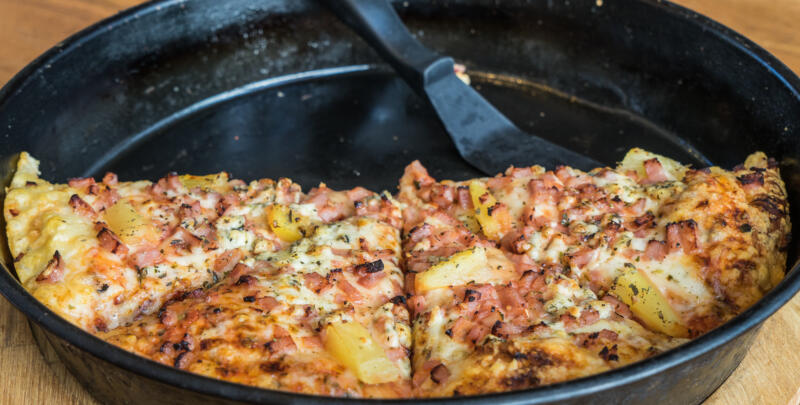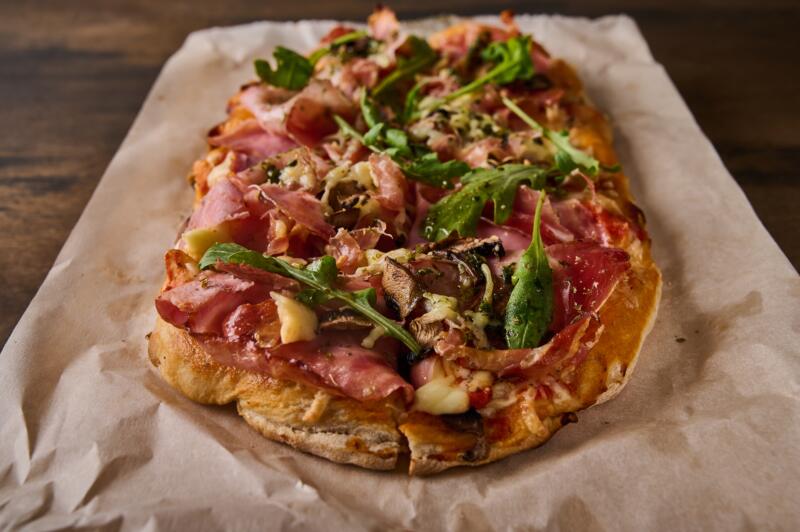You know how it goes – it’s Friday night, you’ve ordered way too much pizza, and now you’re staring at the leftovers wondering, “How long can you leave pizza out before it goes bad?”

We’ve all been there, and it’s a valid question. In this article, we’ll dive into the specifics of pizza safety, the two-hour rule, and the best practices for storing and reheating your favorite slices.
In this article:
What is the Two-Hour Rule?

The two-hour rule is a USDA guideline in food safety that suggests perishable food, like our beloved pizza, should not be left out at room temperature for more than two hours.
This rule is based on the understanding that bacteria and germs, which can cause foodborne illnesses, multiply rapidly between 40°F (4°C) and 140°F (60°C).
When pizza is left out beyond this two-hour window, it becomes unsafe to consume due to the accelerated growth of bacteria and germs.
The potential health hazards of consuming pizza left out for too long can range from mild discomfort to severe food poisoning.
So, next time you have a pizza party, remember the two-hour rule to keep everyone safe and healthy.
Potential Health Hazards of Consuming Pizza Left Out Too Long

Before we dive into the specific health hazards, it’s important to understand the broader implications of consuming pizza that’s been sitting out too long.
The risks are not just about a bad taste or a less-than-ideal texture. The real concern lies in the invisible world of bacteria and germs that can lead to serious illnesses.
Food Poisoning and Foodborne Illness
Food poisoning and foodborne illnesses are often the result of consuming food, like pizza, that has been left out for too long.
These conditions can be caused by various types of bacterial food poisoning, including Bacillus cereus, Listeria, Salmonella, and Staphylococcus aureus.
Bacillus cereus can cause nausea, vomiting, and diarrhea, while Listeria can lead to fever, muscle aches, and even more serious complications in people with weakened immune systems.
Salmonella is notorious for causing diarrhea, fever, and abdominal cramps.
Staphylococcus aureus, on the other hand, can lead to nausea, vomiting, and stomach cramps. These germs are not something you want to invite to your pizza party!
Growth of Pathogenic Bacteria in Perishable Foods

Pizza, like other perishable foods, can harbor pathogenic bacteria, especially when not stored properly.
When pizza is left at room temperature, bacteria can multiply rapidly, potentially leading to foodborne illnesses.
The growth of these bacteria is particularly rapid in the “danger zone” between 40°F and 140°F (4°C and 60°C).
Remember, when it comes to pizza and other perishable foods, it’s always better to be safe than sorry.
Role of Pizza Ingredients in Spoilage
The ingredients on your pizza can play a significant role in how quickly it spoils.
Different toppings can affect the rate of spoilage and the growth of mold.
For instance, meats and cheeses, which are high in protein and moisture, can spoil faster than other ingredients.
These foods offer a perfect habitat for bacteria and mold, especially when left out at room temperature.
So, while that extra cheese or pepperoni might be tempting, remember that they can also make your pizza spoil faster if it’s left out for too long.
Storing Pizza

Let’s explore the best ways to store your pizza to maintain its freshness and flavor.
Airtight Containers vs. Cardboard Boxes
Storing fresh pizza in airtight containers has several benefits. These containers prevent bacterial growth by keeping out air and moisture, which are essential for bacteria to thrive.
This method of storage helps to maintain the pizza’s freshness and flavor for a longer period.
On the other hand, storing pizza in a cardboard box can lead to faster spoilage.
Cardboard boxes are not airtight and can absorb the pizza’s moisture, leading to a dry and stale crust.
So, for fresh pizza storage, consider using airtight containers over the traditional cardboard box.
Refrigerated or Frozen Pizza Storage

When it comes to refrigerated pizza storage, it’s best to use a tightly sealed container, bag, or plastic wrap.
This prevents the pizza from drying out and helps maintain its taste and texture.
Remember, refrigerated pizza should be consumed within three to four days.
For longer storage, freezing is an option. Proper storage of frozen pizza includes using a tightly sealed container or bag to maintain its quality.
Frozen pizza can be stored for up to three months, making it a convenient option for a quick meal.
Reheating Options for Leftover Slices

There are several options available for reheating leftover pizza slices. Each method has its own benefits and can bring your leftover slices back to life.
Microwave vs. Oven Reheating of Slices
Reheating pizza slices in a microwave versus an oven can yield different results. The microwave is quick and convenient, but it can make the crust soggy.
The oven, on the other hand, takes a bit longer but can restore the pizza’s crispy crust and melty cheese.
For microwave reheating, use high power for 1-2 minutes. For oven reheating, preheat the oven to 375°F (190°C) and bake for 10-15 minutes.
The choice between the two often comes down to a trade-off between texture, taste, and convenience.
Pan Reheating
Another effective method to reheat pizza and maintain its texture is using a pan on the stovetop. This method can make the pizza hot and crunchy.
To reheat pizza in a pan, heat the pan over medium heat and add the pizza slice.
Heat for a couple of minutes, then add a few drops of water to the pan (away from the pizza) and cover the pan immediately to create steam.
The steam helps melt the cheese without making the crust soggy. After a couple of minutes, remove the lid and let the pizza cook for another minute or so to allow any excess moisture to evaporate and the crust to get crispy.
Temperature Considerations for Reheating Pizza Slice Safety
Regardless of how you choose to reheat a leftover pizza, the goal is to heat it to a safe temperature.
For most methods, this means heating the pizza until the cheese is melted and the crust is crispy. This not only guarantees safety but also enhances both taste and consistency.
How Long Can Pizza Sit Out?

We’ve all been there – you’ve ordered more pizza than you can eat, and now you’re left with a few slices sitting out. How long can they safely stay there?
Let’s delve into the specifics of pizza safety and the two-hour rule.
Two-Hour Rule
The Two-Hour Rule is an important guideline for determining the safety of consuming pizza left out at room temperature.
According to this rule, pizza can sit out for up to two hours if the temperature is between 40°F (4°C) and 90°F (32°C).
Exceeding the two-hour mark can lead to bacterial growth and potential foodborne illness.
Ideal Temperature for Safe Consumption After Sitting Out For Two Hours
The ideal temperature for safe consumption of pizza that has been sitting out for two hours is below 40°F (4°C).
This is the temperature at which your refrigerator should be set to keep your pizza fresh for longer.
If the room temperature is between 40°F (4°C) and 90°F (32°C), pizza can remain out for a maximum of two hours before it begins to spoil.
However, to prevent any potential spoilage, it’s recommended to store pizza in the refrigerator immediately after you’re done eating. This way, you can enjoy your leftover slices safely the next day.
Closing Thoughts
We’ve covered a lot of ground in this article, from understanding the two-hour rule to the best practices for storing and reheating pizza.
Remember, the key to enjoying leftover pizza safely is understanding how quickly bacteria can grow and taking the right steps to prevent it.
Don’t let your love for pizza turn into a food safety hazard! Try these techniques next time you find yourself with leftover slices.
And as always, if you have any questions or comments, feel free to share them below. We’re all in this pizza-loving journey together!